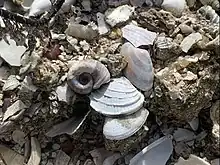Planorbella duryi
Planorbella duryi, common name the Seminole rams-horn, is a species of air-breathing freshwater snail, a pulmonate gastropod mollusk in the family Planorbidae, the ram's horn snails. The species is endemic to Florida and is found frequently in home aquariums.
| Planorbella duryi Temporal range: Piacenzian - recent | |
|---|---|
 | |
| A live Planorbella duryi individual | |
| Scientific classification | |
| Domain: | Eukaryota |
| Kingdom: | Animalia |
| Phylum: | Mollusca |
| Class: | Gastropoda |
| Subclass: | Heterobranchia |
| Superorder: | Hygrophila |
| Family: | Planorbidae |
| Genus: | Planorbella |
| Species: | P. duryi |
| Binomial name | |
| Planorbella duryi (Wetherby, 1879) | |
| Synonyms | |
| |
Description

In the wild they are brown.[1] In captivity they have been bred to come in many colours. These colours are:
- Brown
- Brown leopard
- Blue
- Blue leopard
- Red/orange
- Pink
- Green
- Purple[2]
Distribution

This species of snail is endemic to the freshwater ecosystems of the US state of Florida.[3] Fossils of the species have been found dating back to the Piacenzian, in the Tamiami formation.
It has been introduced to Hawaii and lives in the wild there.[4] It is an introduced species in various European islands and countries including:[5]
- Great Britain as a "hothouse alien"
- Ireland as a "hothouse alien"
- Poland
- Hungary
- Parts of Southern Nigeria [e.g Ogun State, Lagos, Oyo]
Habitat
They are found in most freshwater habitats including streams and ponds.[6]
Conservation status
This species is listed by natureserve as G5.[7]
Diet
They eat dead or decaying plants or fish, and algae.[8]
Breeding
They are hermaphrodites. They lay eggs and are very fast breeders.[9]
Human use
They are a very common aquarium snail. Eggs can get into aquariums on plants. Some people consider them pests due to their ability to breed very fast and overpopulate. Other people value them as part of their clean up crew.[10]
References
- "PLANORBIDAE, Helisoma duryi | Conchology". conchology.be.
- "Ramshorn Snail: Care, Colors & Info (+ Why You Need Them)". pure gold fish.
- "AnimalBase :: Helisoma duryi species homepage". animalbase.
- "Planorbella duryi". hbs.bishopmuseum.
- "AnimalBase :: Helisoma duryi species homepage". animalbase.
- "Planorbella duryi". hbs.bishopmuseum.
- "Planorbella duryi | NatureServe Explorer 2.0". natureserve Explorer.
- "Ramshorn Snails - Detailed Guide: Care, Diet and Breeding". aquarium breeder.
- "Ramshorn Snail Care, Size, Food, Reproduction, Lifespan - Video". aquarium care basics.
- "Ramshorn Snail Guide | Removal & Information". Aquarium info.
External links
- images
- AnimalBase info at: "AnimalBase :: Helisoma duryi species homepage". animalbase.